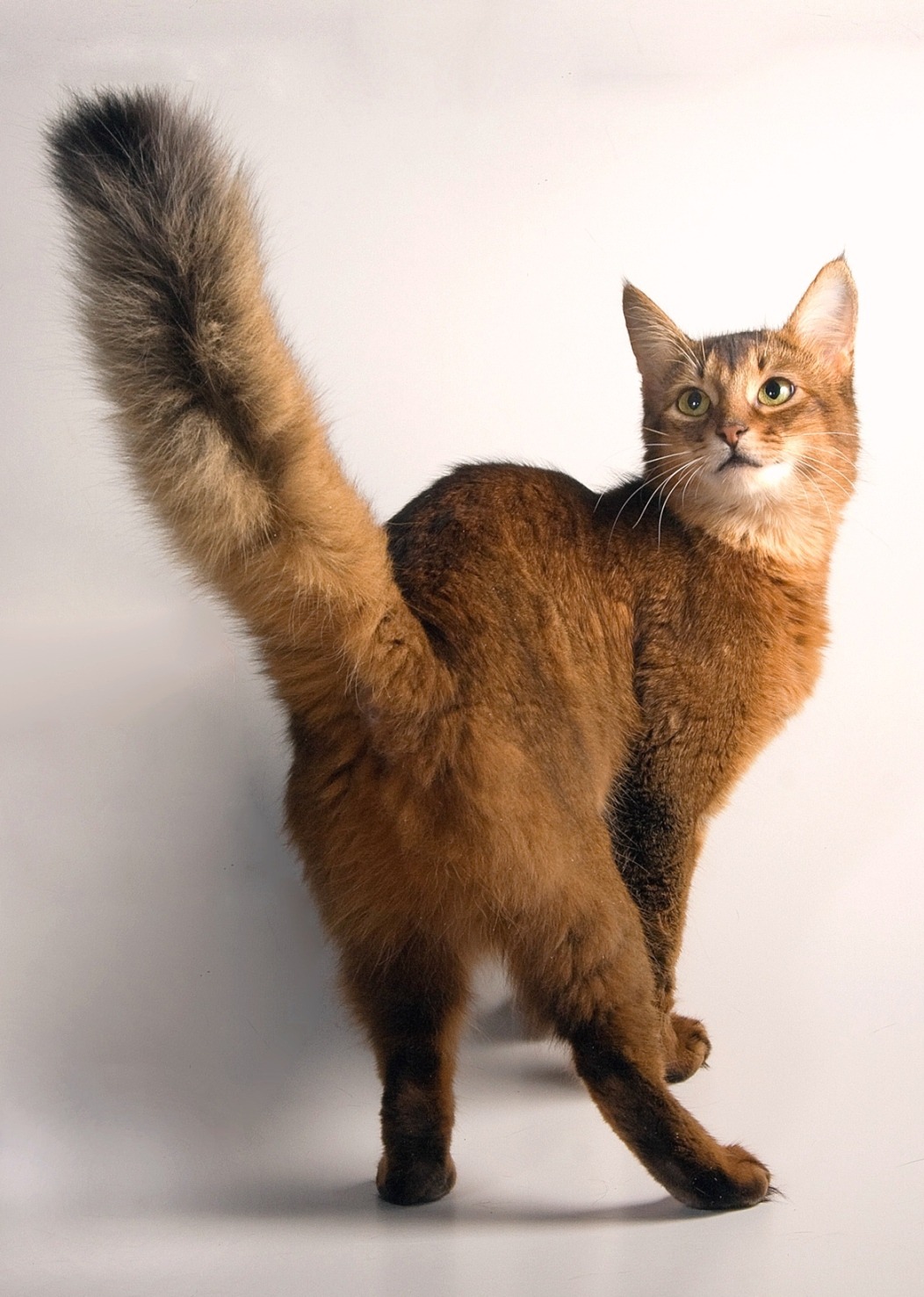Regarded as the Abyssinians sibling, the Somali cat is the former’s long haired version that possesses the same confidence and muscly physique. It is a highly inquisitive and brilliant feline, and nothing escapes its curiosity. Brimming with energy, she will climb high points in the house, explore every nook, jump incredible distances, and play her hearts out. The Somali cat is animated and determined, making this feline a glamorous and entertaining addition to any home.
Origin of the Somali Cat
The Somali cat is typically the long haired counterpart of the Abyssinian cat. However, despite its name, this feline did not originate from Somalia, Ethiopia’s neighboring country (formerly known as Abyssinia.)
Abyssinian cats became popular due to their short, tight-lying fur and ticking pattern, which resembles African wild rabbits. However, some of the kittens born from breeding the Abyssinians were long haired, which was not a preferable characteristic for the breed.
Fortunately, some cat enthusiasts felt otherwise and desired the longhaired look on the Abyssinian. In the latter part of the 1960s, these breeders developed the longhaired variety of the Abyssian cat and named it the Somali. Other breeds incorporated into its gene pool may have included the Siamese, Russian Blues, and the Burmese. While the Abyssinian is renowned, the Somali is less known but is slowly gaining popularity.
Physical Characteristics of the Somali Cat
Length: 11 to 14 inches
Weight: 10 to 12 pounds (Males), 6 to 10 pounds (Females)
Life Expectancy: 11 to 16 years
Coat Color: Ruddy, fawn, blue, red
Type of Coat: Medium, fine, and soft
Eye Color: Gold, Green
Somali cats are fairish-sized felines with a slender, muscly body. They have a triangular head, with large ears sitting atop, tilting forward, that provide them an alert appearance. Their large eyes, which look big for their face, radiate their innate brilliance and attentiveness. Meanwhile, their coat is full and soft, with their tail being fuzzy, while massive hair tufts occur on the ears. The fur appears to be darker on their back, lighter on their sides, inside their legs, and under their neck.
Somali Cat Personality
Given their Abyssinian ancestry, the Somali cats are highly inquisitive, brimming with athleticism, and have big hearts for play. They are not cats that would be content lying around the house all day, as they are boisterous and are always on the move.
Expect these furballs to survey different areas around the house, watch birds or squirrels from the windows, climb on high points, or partake in any activity their owners’ are doing.
Moreover, Somali cats animated, and they deem that everything is an act of play. They will be happy to chase balls, play fetch, or smack fishing poles or wands with feathered ends. If their owners stop playing with them, these felines are ready to tap them gently or stare at them with their large eyes, asking for another round of fun.
These furballs are not all vigor, though, as they have their affectionate side. They are people-oriented and love to be the center of attention, but they are not lap cats. Picking them up for a cuddle is a big no-no, and they would rather stay by their owners’ side on the couch or at the end of the bed.
Lastly, as highly curious cats, they often get into cute mischiefs. They have a habit of opening cupboards, cabinets, or drawers, followed by loud noises from various stuff hitting the floor. These felines are determined, which often gets them into trouble. Nevertheless, they are adorable and entertaining creatures that add fun to many homes.
Caring for the Somali Cat
Somali cats’ mid-length coat is relatively easy to maintain. Brushing them one to two times weekly is enough to remove dirt, debris, and dead hair, distribute natural skin olds, and keep them from mats and tangles. However, these cats shed during the spring in preparation for its winter coat, which may require frequent grooming. While bathing is rarely necessary, it can vastly help remove loose hair from their fur and keep it in its tip-top condition.
As with other cat breeds, Somali cats can be vulnerable to periodontal disease. Cleaning their teeth daily is the best resort, but weekly brushing is enough to boost their oral health. Other grooming upkeep they need include regular nail trimming every few weeks and weekly ear and eye cleaning.
For the ears, it is best to use a soft cloth in wiping any dirt or debris. Cotton swabs are discouraged as it can easily cause damage to these cats’ delicate inner ear structures. Meanwhile, a dampened soft cloth can be used for the eyes to wipe the eye corners and clean any discharge.
In terms of health, Somali cats are sturdy, but there are certain conditions to look out for, such as patellar luxation, progressive retinal atrophy, and renal amyloidosis. Proper nutrition and regular visit to the vet can rule out any condition, prevent it from getting out of hand, and ensure that they live a long, healthy life.
With their animated and determined demeanor, Somali cats are ideal for cat enthusiasts looking for an active and intelligent companion to add to their home. These cats will be happiest to be with families that can match their high energy, be tolerant of their little mischief, in exchange for their pure affection.

